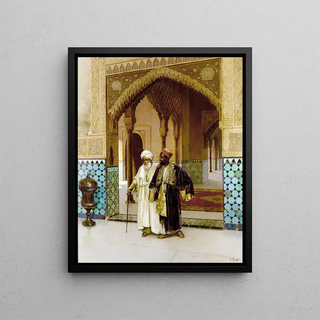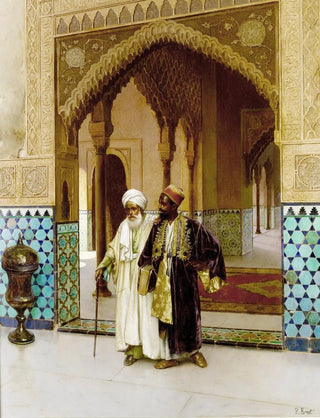Art print | After the Prayers - Rudolf Ernst


View from behind

Frame (optional)
Art print After the Prayers - Rudolf Ernst – Captivating Introduction
In the fascinating universe of oriental painting, Rudolf Ernst's "After the Prayers" stands out for its narrative depth and refined aesthetics. This canvas invites the viewer to enter a world imbued with serenity and spirituality, where every detail seems to tell a story. The artist, through his skill in capturing the nuances of light and the textures of fabrics, manages to create an atmosphere that is both intimate and universal. The work, depicting characters in full contemplation after a moment of prayer, evokes a pause in time, a moment of reflection that resonates with the viewer's soul.
Style and uniqueness of the work
The uniqueness of "After the Prayers" lies in how Rudolf Ernst combines realism with a certain idealization of characters and scenes. The warm, rich colors, the play of shadow and light, as well as the meticulous details, especially in traditional clothing, reveal impressive technical mastery. Each face is rendered with such expressiveness that it almost seems alive, as if it could share its thoughts and emotions. The composition, meanwhile, is carefully orchestrated, guiding the eye through the scene while maintaining a harmonious balance. This painting does not merely depict a scene; it invites meditation on spirituality and culture, thus making the aesthetic experience deeply immersive.
The artist and his influence
Rudolf Ernst, an Austrian-born painter, is recognized for his exploration of oriental themes, which he integrated into his work throughout his career. His fascination with the Orient led him to travel across countries such as Morocco and Egypt, where he drew inspiration. The influences of these journeys are palpable in "After the Prayers," where the artist succeeds in transcribing the beauty and richness of the cultures he encountered. Ernst managed to create a bridge between the Orient and the West, making his works witnesses to a cultural dialogue. His style, which combines precision and romanticism, left its mark on his contemporaries and continues to inspire many artists today. Through his canvases, he was able to capture the essence of an era and

Matte finish

View from behind

Frame (optional)
Art print After the Prayers - Rudolf Ernst – Captivating Introduction
In the fascinating universe of oriental painting, Rudolf Ernst's "After the Prayers" stands out for its narrative depth and refined aesthetics. This canvas invites the viewer to enter a world imbued with serenity and spirituality, where every detail seems to tell a story. The artist, through his skill in capturing the nuances of light and the textures of fabrics, manages to create an atmosphere that is both intimate and universal. The work, depicting characters in full contemplation after a moment of prayer, evokes a pause in time, a moment of reflection that resonates with the viewer's soul.
Style and uniqueness of the work
The uniqueness of "After the Prayers" lies in how Rudolf Ernst combines realism with a certain idealization of characters and scenes. The warm, rich colors, the play of shadow and light, as well as the meticulous details, especially in traditional clothing, reveal impressive technical mastery. Each face is rendered with such expressiveness that it almost seems alive, as if it could share its thoughts and emotions. The composition, meanwhile, is carefully orchestrated, guiding the eye through the scene while maintaining a harmonious balance. This painting does not merely depict a scene; it invites meditation on spirituality and culture, thus making the aesthetic experience deeply immersive.
The artist and his influence
Rudolf Ernst, an Austrian-born painter, is recognized for his exploration of oriental themes, which he integrated into his work throughout his career. His fascination with the Orient led him to travel across countries such as Morocco and Egypt, where he drew inspiration. The influences of these journeys are palpable in "After the Prayers," where the artist succeeds in transcribing the beauty and richness of the cultures he encountered. Ernst managed to create a bridge between the Orient and the West, making his works witnesses to a cultural dialogue. His style, which combines precision and romanticism, left its mark on his contemporaries and continues to inspire many artists today. Through his canvases, he was able to capture the essence of an era and






